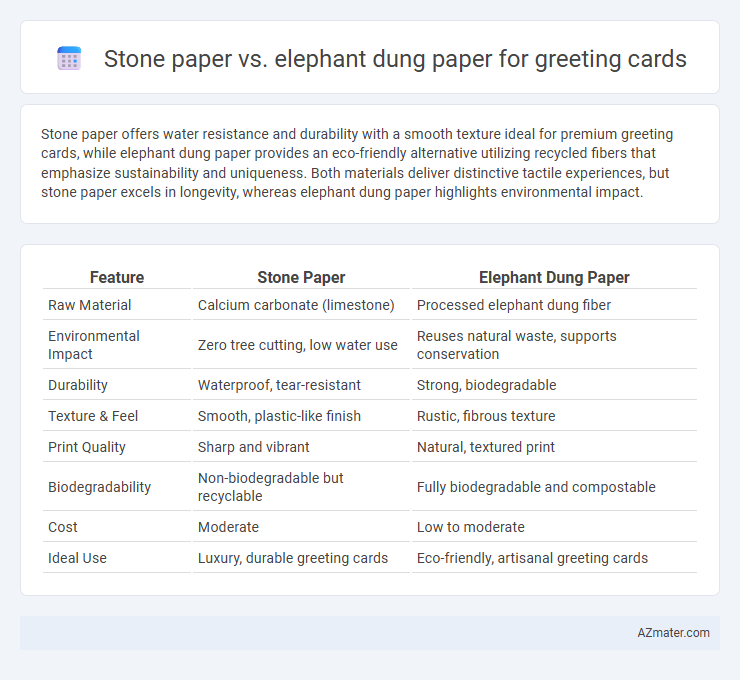Stone paper offers water resistance and durability with a smooth texture ideal for premium greeting cards, while elephant dung paper provides an eco-friendly alternative utilizing recycled fibers that emphasize sustainability and uniqueness. Both materials deliver distinctive tactile experiences, but stone paper excels in longevity, whereas elephant dung paper highlights environmental impact.
Table of Comparison
| Feature | Stone Paper | Elephant Dung Paper |
|---|---|---|
| Raw Material | Calcium carbonate (limestone) | Processed elephant dung fiber |
| Environmental Impact | Zero tree cutting, low water use | Reuses natural waste, supports conservation |
| Durability | Waterproof, tear-resistant | Strong, biodegradable |
| Texture & Feel | Smooth, plastic-like finish | Rustic, fibrous texture |
| Print Quality | Sharp and vibrant | Natural, textured print |
| Biodegradability | Non-biodegradable but recyclable | Fully biodegradable and compostable |
| Cost | Moderate | Low to moderate |
| Ideal Use | Luxury, durable greeting cards | Eco-friendly, artisanal greeting cards |
Introduction to Eco-Friendly Greeting Card Papers
Stone paper and elephant dung paper offer innovative, eco-friendly alternatives to traditional wood pulp greeting cards, significantly reducing environmental impact through sustainable raw materials. Stone paper, made from calcium carbonate bonded with non-toxic resin, boasts waterproof and tear-resistant qualities, while elephant dung paper, crafted from recycled fibers found in elephant feces, supports wildlife conservation and minimizes waste. Both materials exemplify sustainable practices by lowering deforestation and chemical use, making them ideal choices for environmentally conscious greeting card production.
What is Stone Paper?
Stone paper is an eco-friendly alternative made from calcium carbonate and a small amount of resin, offering a smooth, durable, and water-resistant texture ideal for greeting cards. Unlike elephant dung paper, which is crafted from recycled elephant waste fibers, stone paper requires no water or trees in its production, significantly reducing environmental impact. Its unique composition results in a tear-resistant, vibrant print surface that enhances the aesthetic and longevity of greeting cards.
What is Elephant Dung Paper?
Elephant dung paper is an eco-friendly material made by processing the fibrous content found in elephant feces into pulp, creating a sustainable alternative to traditional wood-based papers. This paper retains a unique texture and natural earthy tone, making it ideal for handcrafted greeting cards that emphasize environmental conservation. Unlike stone paper, which is derived from calcium carbonate and synthetic resins, elephant dung paper promotes waste reuse and supports wildlife protection initiatives.
Environmental Impact Comparison
Stone paper, made from calcium carbonate and non-toxic resins, offers a waterproof and tear-resistant alternative with a significantly lower water footprint and no tree usage, reducing deforestation impacts. Elephant dung paper utilizes recycled fibers from elephant excrement, effectively repurposing waste and supporting elephant conservation while requiring less energy and chemicals compared to conventional paper. Both options minimize environmental harm by reducing reliance on traditional wood pulp, but stone paper excels in durability and water conservation, whereas elephant dung paper promotes wildlife sustainability and waste reduction.
Production Process: Stone Paper vs Elephant Dung Paper
The production process of stone paper involves grinding limestone into a fine powder and mixing it with non-toxic resins to create a durable, water-resistant material without using water or trees. Elephant dung paper is made by cleaning and sterilizing elephant dung fibers, which are then mixed with recycled paper pulp and formed into sheets through a traditional paper-making process. While stone paper production emphasizes minimal environmental impact by avoiding water and chemicals, elephant dung paper utilizes natural fiber recycling and waste reduction but requires more water and energy for fiber cleaning and sterilization.
Texture and Printability
Stone paper offers a smooth, water-resistant texture that enables vibrant, sharp print quality ideal for detailed greeting cards. Elephant dung paper presents a fibrous, coarse texture providing a rustic, eco-friendly aesthetic but may result in slightly muted prints with less precision. Both options support sustainable production, though stone paper excels in consistent printability, while elephant dung paper emphasizes artisanal uniqueness.
Durability and Water Resistance
Stone paper offers superior durability and water resistance compared to elephant dung paper, making it ideal for greeting cards that need to withstand handling and moisture. Its synthetic composition provides tear-proof and waterproof qualities, whereas elephant dung paper, which contains natural fibers and organic material, tends to be less water-resistant and more susceptible to wear. For greeting cards requiring long-lasting resilience and protection against spills, stone paper is the more reliable choice.
Aesthetic Appeal for Greeting Cards
Stone paper offers a smooth, matte finish with vibrant print quality, enhancing the visual appeal and tactile experience of greeting cards. Elephant dung paper provides a unique, rustic texture with visible fibers, creating an eco-friendly and artisanal charm that stands out. Both materials deliver distinct aesthetics, with stone paper favoring modern elegance and elephant dung paper highlighting sustainable creativity.
Price and Market Availability
Stone paper greeting cards generally cost more due to their eco-friendly production using crushed stone and resin, but they are widely available in specialty stores and online eco-friendly marketplaces. Elephant dung paper products tend to be priced competitively, often lower than stone paper, as they utilize recycled fibers from elephant dung, appealing to niche markets focused on sustainability and wildlife conservation. Market availability for elephant dung paper cards is more limited, commonly found in eco-tourism shops and select online platforms supporting social enterprises.
Best Choice for Sustainable Greeting Cards
Stone paper offers durability, water resistance, and eco-friendliness by using mineral-based fibers without tree cutting or water pollution, making it a strong contender for sustainable greeting cards. Elephant dung paper provides a unique recycling solution by repurposing elephant waste into biodegradable and fiber-rich paper, supporting wildlife conservation and reducing landfill waste. For the best choice in sustainable greeting cards, stone paper excels in longevity and resource efficiency while elephant dung paper excels in upcycling and community impact, with the final decision depending on specific sustainability priorities and aesthetic preferences.

Infographic: Stone paper vs Elephant dung paper for Greeting card
 azmater.com
azmater.com